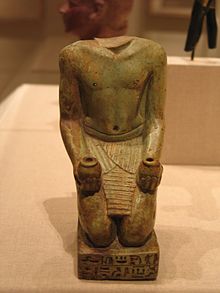Egyptian faience
The sintering process "covered [the material] with a true vitreous coating" as the quartz underwent vitrification, creating a bright lustre of various colours "usually in a transparent blue or green isotropic glass".
[4] The well-known blue hippopotamus figurines, placed in the tombs of officials, can be up to 20 cm (7.9 in) long,[5] approaching the maximum practical size for Egyptian faience, though the Victoria and Albert Museum in London has a 215.9-centimetre (85.0 in) sceptre, dated 1427–1400 BC.
Egyptian faience was both exported widely in the ancient world and made locally in many places, and is found in Mesopotamia, around the Mediterranean and in northern Europe as far away as Scotland.
The British Museum now calls this material "glazed composition", with the following note in their online collection database: The term is used for objects with a body made of finely powdered quartz grains fused together with small amounts of alkali and/or lime through partial heating.
Glazed in these colours, faience was perceived as substitute for blue-green materials such as turquoise, found in the Sinai Peninsula, and lapis lazuli from Afghanistan.
[9] As early as the Predynastic graves at Naqada, Badar, el-Amrah, Matmar, Harageh, Avadiyedh and El-Gerzeh, glazed steatite and faience beads are found associated with these semi-precious stones.
[7] The symbolism embedded in blue glazing could recall both the Nile, the waters of heaven and the home of the gods, whereas green could possibly evoke images of regeneration, rebirth and vegetation.
[7] While in most instances domestic ores seem to have provided the bulk of the mineral pigments, evidence suggests that during periods of prosperity, raw materials not available locally, such as lead and copper, were imported.
[7] Modeling, scraping and grinding are the techniques most widely used in earlier times, as represented in the material qualities of Predynastic and Protodynastic faience objects.
[14] In this period, sculptural detail is created using inlays of different colored faience or by scraping the body to reveal the white intermediate layer in relief.
[10] Moulds could facilitate mass production of faience objects such as amulets rings and inlays, as evidenced by the several thousand of small open face, earth-ware clay molds excavated at Tell el Amarna.
[13] The level of standardisation that use of moulds produced varied, with a compositional and morphological study of faience ushabtis suggested that mass-production is an oversimplification of a complex process that may more accurately described as batch-processing.
[20] Wheel throwing, possibly occurring from the New Kingdom onwards, is certainly established by the Greco-Roman period, when large amounts of clay seem to have been added to the faience body.
[14][21] Ptolemaic and Roman faience tends to be typologically and technologically distinct from the earlier material: it is characterized by the widespread use of moulding and high relief on vessels.
[22] A very unusual and finely made group of figures of deities and falcons in the Metropolitan Museum of Art in New York, apparently representing hieroglyphs that are elements from a royal inscription, perhaps from a wooden shrine, is decorated in a form of champlevé (typically a technique for enamel on metal).
In the application method, formerly assumed to be the only one used for faience glazing; silica, lime and alkalis are ground in the raw state to a small particle size, thus mixed in water to form a slurry which is then applied to the quartz core.
[14] In the self-glazing process of efflorescence, the glazing materials, in the form of water-soluble alkali salts, are mixed with the raw crushed quartz of the core of the object.
[26] In this method the artifact, while buried in a glazing powder with a high flux content, is heated inside a vessel, causing the fusion of the object with the cement.
[29] In high magnification the interstitial glass is extensive; the unreacted salts which have not reached the surface fuse of the body accumulate in the core, creating bridges between the quartz particles.
However, variant A describes a technologically unique product and as such is still applicable: it has a finely ground underglaze consisting of quartz particles in a glass matrix, often revealed by incisions or depressions cut into the overlying glaze.
[12][22] Glassy faience, variant E, displays no distinct outer layer from the interior, thus it has been suggested that the term 'faience' is a misnomer and the alternative name 'imperfect glass' has been advised.












